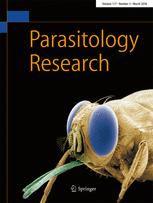Ver ítem
- xmlui.general.dspace_homeCentros Regionales y EEAsCentro Regional Santa FeEEA RafaelaArtículos científicosxmlui.ArtifactBrowser.ItemViewer.trail
- Inicio
- Centros Regionales y EEAs
- Centro Regional Santa Fe
- EEA Rafaela
- Artículos científicos
- Ver ítem
The Ixodes ricinus complex (Acari: Ixodidae) in the Southern Cone of America: Ixodes pararicinus, Ixodes aragaoi, and Ixodes sp. cf. I. affinis
Resumen
The goal of this study was to clarify the taxonomic status of the Ixodes ricinus complex in the Southern Cone of America, by using morphological characters and molecular markers (mitochondrial 16SrDNA and cox1 genes). The morphological analysis indicates that three different taxa of the I. ricinus complex occur in this region: Ixodes pararicinus, Ixodes aragaoi, and Ixodes sp. cf. I. affinis. The most prominent diagnostic character among them is the size
[ver mas...]
The goal of this study was to clarify the taxonomic status of the Ixodes ricinus complex in the Southern Cone of America, by using morphological characters and molecular markers (mitochondrial 16SrDNA and cox1 genes). The morphological analysis indicates that three different taxa of the I. ricinus complex occur in this region: Ixodes pararicinus, Ixodes aragaoi, and Ixodes sp. cf. I. affinis. The most prominent diagnostic character among them is the size of scutal punctations in both male and female ticks. In the males of Ixodes sp. cf. I. affinis, the punctations on the central field and along the median marginal groove of the scutum are clearly larger than in the males of I. aragaoi and I. pararicinus, while the punctations of I. aragaoi are larger but less numerous than in I. pararicinus. The punctations in Ixodes sp. cf. I. affinis females are larger and deeper than in females of I. aragaoi and I. pararicinus, and those of I. aragaoi are slightly larger than in I. pararicinus. The length of the lateral posterior denticles of the male hypostome is comparatively longer in I. aragaoi than in the other two species, and longer in Ixodes sp. cf. I. affinis than in I. pararicinus. In the 16S analysis, I. pararicinus and I. aragaoi are monophyletic (99% and 98% bootstrap support, respectively), while Ixodes cf. I. affinis does not represent a single lineage. In the cox1 analysis, both I. pararicinus and I. aragaoi are well-defined taxa, but the bootstrap support for Ixodes sp. cf. I. affinis is low (67%). In general, there are considerable 16SrRNA differences among lineages of Ixodes sp. cf. I. affinis from different geographical areas. These results may be indicative of the existence of different species. The populations morphologically compatible with I. affinis from Argentina, Colombia, Panama, Belize, and USA should be provisionally named as Ixodes sp. cf. I. affinis until an integrative taxonomic work with further evidence redefines whether or not this taxon actually represents a species complex.
[Cerrar]

Autor
Saracho Bottero, Maria Noelia;
Venzal, José Manuel;
Tarragona, Evelina Luisa;
Thompson, Carolina Soledad;
Mangold, Atilio Jose;
Beati, Lorenza;
Guglielmone, Alberto;
Nava, Santiago;
Fuente
Parasitology Research : 1–12 (First Online: 28 November 2019)
Fecha
2019-11
Editorial
Springer
ISSN
0932-0113
1432-1955
1432-1955
Formato
pdf
Tipo de documento
artículo
Palabras Claves
Derechos de acceso
Restringido
 Excepto donde se diga explicitamente, este item se publica bajo la siguiente descripción: Creative Commons Attribution-NonCommercial-ShareAlike 2.5 Unported (CC BY-NC-SA 2.5)
Excepto donde se diga explicitamente, este item se publica bajo la siguiente descripción: Creative Commons Attribution-NonCommercial-ShareAlike 2.5 Unported (CC BY-NC-SA 2.5)

